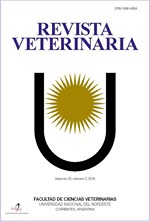Age, sex, year season, and handling system modify the leukocytal parameters from captive Caiman latirostris and Caiman yacare (Crocodylia: Alligatoridae)
DOI:
https://doi.org/10.30972/vet.1711963Palabras clave:
Caiman latirostris, Caiman yacare, leukocyte concentration, differential count, physiological variations.Resumen
The purpose of the study was to establish the reference interval for blood leukocytes
from captive northeastern Argentine caimans, as well as to detect physiological variations
related to species, sex, age, year season, and handling system. Samples from 223 healthy
sub–adults, both sexes specimens of Caiman latirostris (n = 109) and Caiman yacare (n =
114), were obtained. White blood cells concentration (13.7±2.5 G/l) and proportion of heterophils
(17.5±3.4%), lymphocytes (75.0±6.8%), monocytes (5.3±1.1%), eosinophils (2.2±0.4%),
and basophils (0.3±0.05%) were determined by reptilian specific techniques. For each type of
cell, largest diameters were, respectively: 14.49±1.54; 8.70±1.01; 12.74±1.85; 12.55±2.15 and
10.77±1.02 um. Heterophils rate was significantly higher in C. yacare than in C. latirostris (p
< 0.05); lymphocytes rate showed an inverse relationship between species. Lymphocytes proportion
was significantly higher in females than in males. The growth progress was reflected
in slight heterophils decrease and lymphocytes increase. Total leukocytes concentration and
lymphocytes percentage were significantly lower in autumn and winter. Decreases of heterophils
(not significant) and monocytes (significant) were registered in summer and spring.
Greater leukocytal differences attributable to handling systems (housing, feeding) used in
a hatchery and a zoo, were not verified. Obtained data are applicable for the diagnosis and
prevention of diseases in these species.
Descargas
Descargas
Publicado
Cómo citar
Número
Sección
Licencia
Derechos de autor 2006 N. B. Mussart, N. N. Barboza, S. A. Fioranelli, G. A. Koza, W. S. Prado, J. A. Coppo

Esta obra está bajo una licencia internacional Creative Commons Atribución-NoComercial 4.0.
Política de acceso abierto
Esta revista proporciona un acceso abierto inmediato a su contenido, basado en el principio de que ofrecer al público un acceso libre a las investigaciones ayuda a un mayor intercambio global de conocimiento. La publicación por parte de terceros será autorizada por Revista Veterinaria toda vez que se la reconozca debidamente y en forma explícita como lugar de publicación del original.
Esta obra está bajo una licencia de Creative Commons Reconocimiento-NoComercial 4.0 Internacional (CC BY-NC 4.0)










.jpg)
.jpg)



